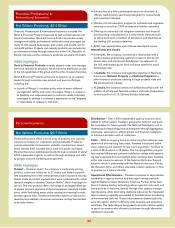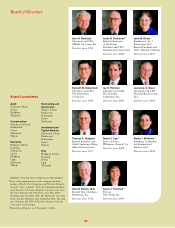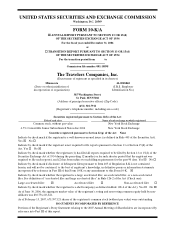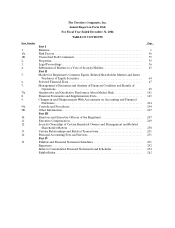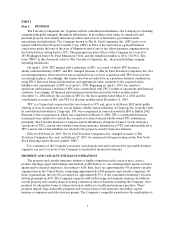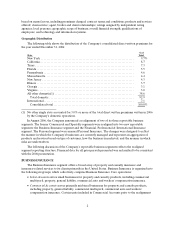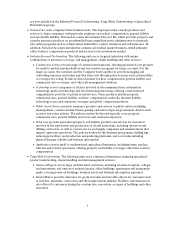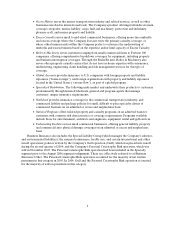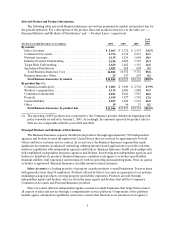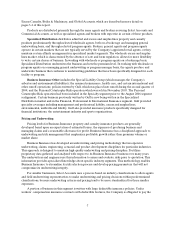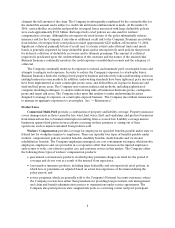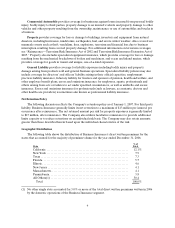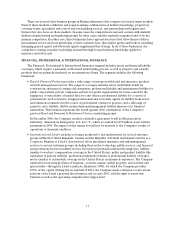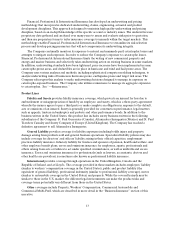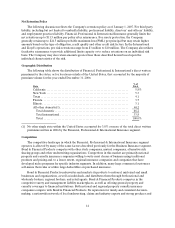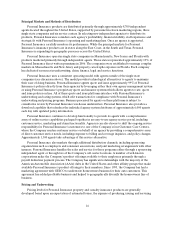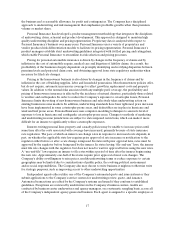Travelers 2006 Annual Report Download - page 19
Download and view the complete annual report
Please find page 19 of the 2006 Travelers annual report below. You can navigate through the pages in the report by either clicking on the pages listed below, or by using the keyword search tool below to find specific information within the annual report.7
Excess Casualty, Boiler & Machinery, and Global Accounts, which are described in more detail on
pages 3-4 of this report.
Products are distributed primarily through the same agents and brokers servicing Select Accounts and
Commercial Accounts, as well as specialized agents and brokers with expertise in certain of these products.
Specialized Distribution distributes admitted and excess and surplus lines property and casualty
products predominantly through selected wholesale agents, both on a brokerage and managing general
underwriting basis, and through selectedprogram agents. Brokers, general agents andprogram agents
operate in certain markets that are not typically served by the Company’s appointed retail agents, or they
maintain certain affinity arrangements inspecialized market segments. The wholesale excess and surplus
lines market, which ischaracterized by the absence of rate and form regulation, allows for more flexibility
to write certain classes of business. In working with wholesale or program agents on a brokerage basis,
Specialized Distribution underwrites the business and sets the premium level. In working with wholesale or
program agents on a managing general underwriting or program manager basis, the agents produce and
underwrite business that conforms to underwriting guidelines that have been specifically designed for each
facility or program.
Business Insurance Other includes the Special Liability Group (which manages the Company’s
asbestos and environmental liabilities); the assumed reinsurance, health care, and certain international and
other runoff operations; policies written by Gulf, which was placed into runoff during the second quarter of
2004; and the Personal Catastrophe Risk operation which was sold in November 2005. The Personal
Catastrophe Risk operation had been included in the Specialty segment prior to the August 2006 segment
realignment. Certain business previously written by Gulf is now being written in the Specialized
Distribution market and in the Financial, Professional & International Insurance segment. Gulf provided
specialty coverages including management andprofessional liability, excess and surplus lines,
environmental, umbrella and fidelity. Gulf also provided insurance products specifically designed for
financial institutions, the entertainment industry and sports organizations.
Pricing and Underwriting
Pricing levels for Business Insurance property and casualty insurance products are generally
developed based upon an expectation of estimated losses, theexpenses of producing business and
managing claims and a reasonable allowance for profit. Business Insurance has a disciplined approach to
underwriting and risk management that emphasizes profitable growth rather than premium volume or
market share.
Business Insurance has developed an underwriting and pricing methodology that incorporates
underwriting, claims, engineering, actuarial and product development disciplines for particular industries.
This approach is designed to maintain high quality underwriting and pricing discipline. It utilizes
proprietary data gathered and analyzed with respect to its Business Insurance business over manyyears.
The underwriters and engineers use this information to assess andevaluate risks prior to quotation. This
information provides specialized knowledge about specific industry segments. This methodology enables
Business Insurance to streamline its risk selection process and developpricing parameters that will not
compromise its underwriting integrity.
For smaller businesses, Select Accounts uses a process based on industry classifications to allow agents
and field underwriting representatives to make underwriting and pricing decisions within predetermined
classifications, because underwriting criteria and pricing tend to be more standardized for these smaller
exposures.
A portion of business in this segment is written with large deductible insurance policies. Under
workers’ compensation insurance contracts with deductible features, the Company is obligated to pay the


